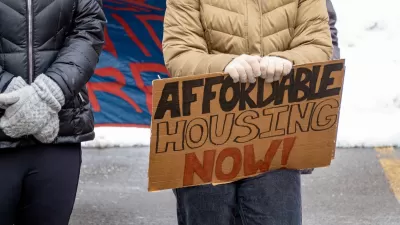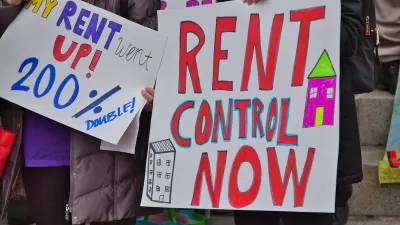The president of Habitat for Humanity has some suggestions for U.S. lawmakers.

In an opinion piece in The Hill, Jonathan Reckford, president and CEO of Habitat for Humanity International, outlines a set of bipartisan actions that the United States Congress could take to address the housing affordability crisis that is impacting more and more American households. As Reckford points out, millions of households spend more than half their income on housing, and homeownership is out of reach for many.
Reckford suggests that Congress should pass the Neighborhood Homes Investment Act, which offers federal tax credits for the rehabilitation of older homes. Additionally, “Robust funding for vital housing and community development federal programs must be a priority in the fiscal year 2025 budget.”
Reckford also recommends prioritizing housing programs in rural areas, where housing costs have been skyrocketing as remote work makes households more mobile. “The Agriculture, Rural Development, Food and Drug Administration Appropriations bill contains the USDA Section 502 Direct Loan Program, which is a mortgage program that assists low- and very-low-income applicants in purchasing a safe, decent, and affordable place to call home.” The program, which did not pass a House vote, needs $1.5 billion in funding.
Reckford points out that “when housing is prioritized, research shows a direct link to improved health outcomes, education and employment. If we, as a nation, care about addressing societal challenges, housing can be the lever to improve so many lives.”
FULL STORY: Even in this election year, America must not lose focus on affordable housing

Planetizen Federal Action Tracker
A weekly monitor of how Trump’s orders and actions are impacting planners and planning in America.

Maui's Vacation Rental Debate Turns Ugly
Verbal attacks, misinformation campaigns and fistfights plague a high-stakes debate to convert thousands of vacation rentals into long-term housing.

San Francisco Suspends Traffic Calming Amidst Record Deaths
Citing “a challenging fiscal landscape,” the city will cease the program on the heels of 42 traffic deaths, including 24 pedestrians.

Amtrak Rolls Out New Orleans to Alabama “Mardi Gras” Train
The new service will operate morning and evening departures between Mobile and New Orleans.

The Subversive Car-Free Guide to Trump's Great American Road Trip
Car-free ways to access Chicagoland’s best tourist attractions.

San Antonio and Austin are Fusing Into one Massive Megaregion
The region spanning the two central Texas cities is growing fast, posing challenges for local infrastructure and water supplies.
Urban Design for Planners 1: Software Tools
This six-course series explores essential urban design concepts using open source software and equips planners with the tools they need to participate fully in the urban design process.
Planning for Universal Design
Learn the tools for implementing Universal Design in planning regulations.
Heyer Gruel & Associates PA
JM Goldson LLC
Custer County Colorado
City of Camden Redevelopment Agency
City of Astoria
Transportation Research & Education Center (TREC) at Portland State University
Jefferson Parish Government
Camden Redevelopment Agency
City of Claremont





























